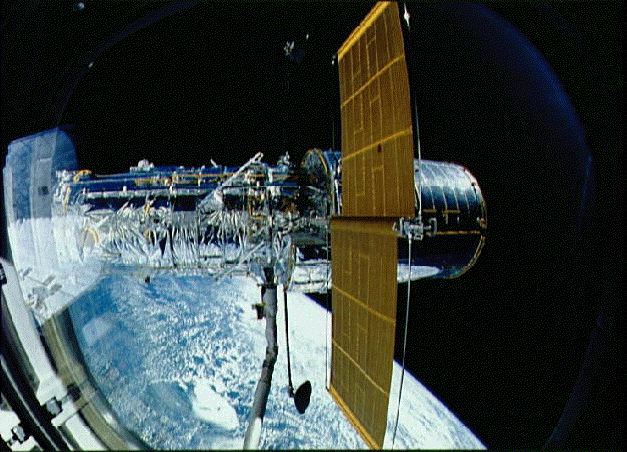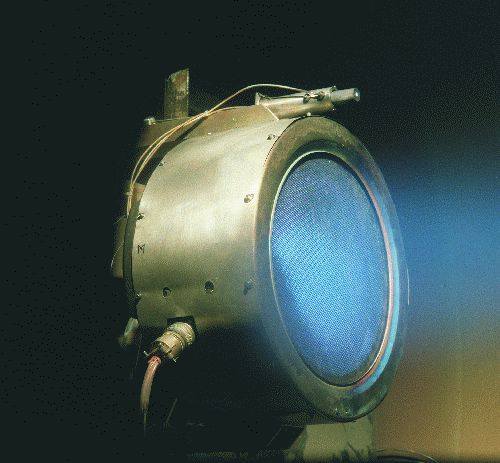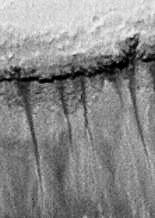






Selected Articles from the
December 2000 Odyssey
Editor: Terry Hancock
The Year 2000
Standing here, in the last month of the twentieth century, it seems like a good time to take some stock in where we are in space.
While 1984 was, as Apple Computer promised us, not like 1984, it's pretty clear that 2001 won't be like 2001 either. But the year 2000 has seen some promising events and powerful discoveries in space.
The Year in Space
Abridged NASA Press Releases, continued.
Part 1 of The Year in Space.
A Triumphant Ten Years in Space for Hubble Telescope
April 11, 2000
 |
| Hubble Space Telescope (HST)
being deployed during the STS-31 flight. NASA. Click here to enlarge. |
A spectacular morning launch of the Space Shuttle Discovery ten years ago, on April 24, 1990, ushered in a new golden age of astronomy. The payload in Discovery's cargo bay, NASA's Hubble Space Telescope, was released by the crew into Earth orbit the next day and the Universe hasn't looked the same since.
In its first ten years, the 12.5-ton Earth-orbiting Hubble has studied 13,670 objects, has made 271,000 individual observations, and has returned 3.5 terabytes of data, which have been archived as a scientific treasure trove for future generations of astronomers. Its rapid-fire scientific achievements have resulted in over 2,651 scientific papers.
Hubble's photographic hall of fame includes the deepest view ever of the Universe in visible light; a peek into the environs of supermassive galactic black holes; the majestic birth of stars in monstrous stellar clouds; planetary systems forming around other stars; extraordinary arcs, shells, and ribbons of glowing gas sculpted by the deaths of ordinary stars; mega-megaton blasts produced by the impact of a comet into the cloud tops of Jupiter; the surface of mysterious Pluto; and galaxies at the edge of space and time.
Hubble will be decommissioned in 2010, and replaced by the Next Generation Space Telescope. Having a much larger mirror, the NGST will pick up where Hubble left off by searching for the faint glimmer of light from the first stars ever born in the Universe. Beyond NGST, ever larger and more advanced telescopes will search for Earth-like extrasolar planets and evidence for life beyond our solar system.
Worlds Smaller than Saturn Found
March 29, 2000
Planet-hunting astronomers have crossed an important threshold in planet detection, with the discovery of two planets that may be smaller in mass than Saturn.
Of the 30 extrasolar planets around Sun-like stars detected previously, all have been the size of Jupiter or larger. The existence of these Saturn-sized candidates suggests that many stars harbor smaller planets, in addition to the Jupiter-sized ones.
Jupiter alone is three times the mass of Saturn. This has left the nagging possibility open that some of the extrasolar planets might really be stillborn stars, called brown dwarfs, which would form like stars through the collapse of a gas cloud. But now researchers are better assured these "Jupiters" are only the tip of the iceberg, and there are many more planets to be found that are the mass of Saturn or smaller.
"Now we are confident we are seeing a distinctly different population of bodies that formed out of dust disks like the disks Hubble Space Telescope has imaged around stars," said Marcy.
Hubble Images a Nearby Isolated Neutron Star
November 9, 2000
NASA's Hubble Space Telescope has caught up with a runaway neutron star believed to be 200 light years away, known as RX J185635-3754.
Such a neutron star, resulting from the core-collapse of a supernova explosion, has the mass of the sun packed into an area about 12 miles in diameter.
"Because this is the closest and brightest of the few known isolated neutron stars, it is the easiest to study and is an excellent test bed for nuclear astrophysical theories, " said Frederick M. Walter of the State University of New York (SUNY), in Stony Brook, NY.
The neutron star's wayward trajectory was caught in three Hubble snapshots taken in 1996 and 1999. The results of the observations are being presented today by the American Astronomical Society's High Energy Astrophysics Division (HEAD) in Honolulu, HI.
This neutron star may have formed about 1 million years ago when a massive star in a binary star system exploded as a supernova, releasing its companion star, an ultra-hot, blue star now known as Zeta Ophiuchus. Because the neutron star and Zeta Ophiuchus were in about the same location in space, RX J185635-3754 may be the remnant of the original binary companion of Zeta Ophiuchus.
The object is very faint (26th magnitude or about 20 billion times fainter than the bright star Vega), and has a blue color. The blue color indicates that the object is hot, about one million degrees Fahrenheit, as expected from the bright X-ray emission.
In September, images taken with the European Southern Observatory's Very Large Telescope showed a small, cone-shaped "bowshock" in front of the neutron star, created as the star plowed through interstellar space.
New Plasma Rocket Technology
June 13, 2000
An agreement to collaborate on development of an advanced rocket technology that could cut in half the time required to reach Mars.
Called the Variable Specific Impulse Magnetoplasma Rocket (VASIMR), the technology has been under development at Johnson's Advanced Space Propulsion Laboratory. The laboratory director is Dr. Franklin Chang-Diaz, a NASA astronaut.
The VASIMR engine consists of three linked magnetic cells. The forward cell handles the main injection of propellant gas and its ionization. The central cell acts as an amplifier to further heat the plasma. The aft cell is a magnetic nozzle, which converts the energy of the fluid into directed flow.
Neutral gas, typically hydrogen, is injected at the forward cell and ionized. The resulting plasma is electromagnetically energized in the central cell by ion cyclotron resonance heating. In this process radio waves give their energy to the plasma, heating it in a manner similar to the way a microwave oven works.
After heating, the plasma is magnetically exhausted at the aft cell to provide modulated thrust. The aft cell is a magnetic nozzle, which converts the energy of the plasma into velocity of the jet exhaust, while protecting any nearby structure and ensuring efficient plasma detachment from the magnetic field.
A key to the technology is the capability to vary, or modulate, the plasma exhaust to maintain optimal propulsive efficiency. This feature is like an automobile's transmission which best uses the power of the engine, either for speed when driving on a level highway, or for torque over hilly terrain.
Deep Space 1 Spacecraft Keeps Going... and Going...
August 15, 2000
 |
| DS1 ion engine test firing. NASA/JPL/Caltech. Click here to enlarge. |
It has the little engine that could, and the pint-sized power plant on board NASA's Deep Space 1 probe has been doing it longer and more efficiently than anything ever launched. The spacecraft, designed to test new technologies, has run its unique propulsion system for more than 200 days (4800 hours).
"The ion propulsion engine on Deep Space 1 has now accumulated more operating time in space than any other propulsion system in the history of the space program," said John Brophy, manager of the NASA Solar Electric Propulsion Technology Applications Readiness project, at the agency's Jet Propulsion Laboratory (JPL) in Pasadena, CA.
"The importance of ion propulsion is its great efficiency," says Dr. Marc Rayman, project manager for Deep Space 1. "It uses very little propellant, and that means it weighs less so it can use a less expensive launch vehicle and ultimately go much faster than other spacecraft."
The ion particles travel out at about 68,000 miles per hour. However, Deep Space 1 doesn't move that fast in the other direction, because it's much heavier than the ion particles. By the end of the mission, the ion engine will have changed the spacecraft's speed by about 6,800 mph (over 11,000 kph).
"This opens the solar system to many future exciting missions which otherwise would have been unaffordable or even impossible," added Dr.Rayman.
The technology is so efficient that it only consumes about 3.5 ounces (100 g) of xenon per day, taking about four days to expend just one pound (0.4 kg).
The only other system that has operated longer is a ground- based replica of the spacecraft's engine. The ongoing extended-life test, being done in a vacuum test chamber at JPL, has run its ion propulsion system for almost 500 days (12,000 hours) and is scheduled to complete nearly 625 days (15,000 hours) by the end of the year.
The Deep Space 1 ion engine could have a total operating time of more than 583 days (14,000 hours) by the end of its mission in the fall of 2001.
Read a firsthand account of Deep Space 1 from OASIS member Robert Gounley, or look for "DS1" on the Search page.
Small Companies to Study Potential Use of Emerging Launch Systems for
Alternative Access to Space Station
August 24, 2000
NASA has awarded four small businesses 90-day contracts totaling $902,000 to develop concepts and requirements to provide access to the International Space Station on emerging launch systems.
These studies could uncover a potential backup capability, augmenting the station's primary resupply vehicles - the US Space Shuttle, Russian Progress, European Space Agency Automated Transfer Vehicle and the Japanese H-II Transfer Vehicles.
Companies selected are:
- Andrews Space and Technology of El Segundo, CA, $195,000
- Microcosm, Inc. of El Segundo, CA, $198,000
- HMX Ltd. of Reno, NV, $245,000
- Kistler Aerospace Corp. of Kirkland, WA, $264,000
The contingency resupply service under study would seek to be capable of launching within a week if necessary and could enhance the Space Station's operational flexibility if primary delivery methods were unavailable. Established launch services companies are studying the same idea under existing contracts managed by NASA's Kennedy Space Center, FL.
Present-day Sources of Liquid Water on Mars? June 22, 2000
 |
| Close up of possible water marks on Mars. NASA. For a larger view, click here. |
In what could turn out to be a landmark discovery in the history of Mars exploration, imaging scientists using data from NASA's Mars Global Surveyor spacecraft have recently observed features that suggest there may be current sources of liquid water at or near the surface of the red planet.
"We see features that look like gullies formed by flowing water and the deposits of soil and rocks transported by these flows. The features appear to be so young that they might be forming today. We think we are seeing evidence of a ground water supply, similar to an aquifer," said Dr. Michael Malin, principal investigator for the Mars Orbiter Camera on the Mars Global Surveyor spacecraft at Malin Space Science Systems (MSSS), San Diego, CA. "These are new landforms that have never been seen before on Mars."
"I think one of the most interesting and significant aspects of this discovery is what it could mean if human explorers ever go to Mars," said Malin. "If water is available in substantial volumes in areas other than the poles, it would make it easier for human crews to access and use it -- for drinking, to create breathable air, and to extract oxygen and hydrogen for rocket fuel or to be stored for use in portable energy sources."
Possible Lake-Bed Sedimentary Structures on Mars
December 4, 2000
In what ultimately may be their most significant discovery yet, Mars scientists say high-resolution pictures showing layers of sedimentary rock paint a portrait of an ancient Mars that long ago may have featured numerous lakes and shallow seas.
"We see distinct, thick layers of rock within craters and other depressions for which a number of lines of evidence indicate that theymay have formed in lakes or shallow seas. We have never before had this type of irrefutable evidence that sedimentary rocks are widespread on Mars," said Dr. Michael Malin, principal investigator for the Mars Orbiter Camera on NASA's Mars Global Surveyor spacecraft at Malin Space Science Systems (MSSS), San Diego, CA. "These images tell us that early Mars was very dynamic and may have been a lot more like Earth than many of us had been thinking." Such layered rock structures where there were once lakes are common on Earth. The pancake-like layers of sediment compressed and cemented to form a rock record of the planet's history.
The regions of sedimentary layers on Mars are spread out and scattered around the planet. They are most common within impact craters of Western Arabia Terra, the inter-crater plains of northern Terra Meridiani, the chasms of the Valles Marineris, and parts of the northeastern Hellas Basin rim. The scientists compare the rock layers on Mars to features seen in the American Southwest, such as the Grand Canyon and the Painted Desert of Arizona.
As an alternative to lakes, Malin and Edgett suggest that a denser atmosphere on early Mars could have allowed greater amounts of windborne dust to settle out on the surface in ways that would have created the sedimentary rock.
"The finding of layered sedimentary deposits is something that biologists have been hoping for," said Dr. Ken Nealson, director of the Center for Life Detection at NASA's Jet Propulsion Laboratory (JPL), Pasadena, CA. "Perhaps the favorite sites for biologists to search for fossils or evidence of past life on Earth are layered lake or oceanic sediments such as in these sites Malin and Edgett describe."
Part 1 of The Year in Space.
Copyright © 1998-2003 Organization for the Advancement of Space Industrialization and Settlement. All Rights Reserved.